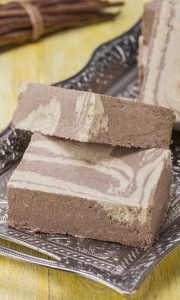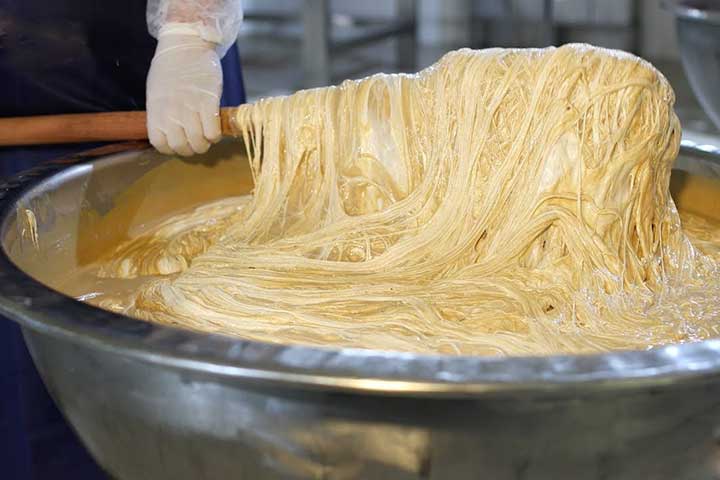In every language, the word sweet implies not just flavor but pleasant, agreeable and happy things. In Turkey, not just the word sweet but the word halva “Turkish: helva” has a similar metaphorical significance. Helva is foremost among the many sweets and puddings which form such a considerable branch of Turkish culinary culture, and also plays a ceremonial and symbolic role on special occasions like weddings and religious feast days.
Although the Turkish love of sweet foods is renowned, this was not the case in the ancient past, as demonstrated by the fact that Central Asian Turkic cuisines are almost completely lacking in sweet dishes. Instead, the Turks acquired their taste for sweet confectionery in the lands of western Asia and the Middle East, where such foods were a deep-rooted tradition and became instrumental in carrying it westwards into Europe.
 Halva comes in myriad varieties but is basically made from wheat flour, starch or semolina, and sugar. Before sugar became widely available at an affordable price for ordinary people, honey or grape molasses were used as sweeteners in these confections. Although the ingredients of helva are very simple, their quality is important, and so is the technique. The flour must be patiently stirred over a slow heat until it becomes amber in color. If you try to speed up the process by turning up the heat, both flavor and color will be spoilt. Traditional recipes usually call for full-fat milk and butter, and although these can be replaced by water and margarine, the taste will not be so delicious. The famous tahin helva made of ground sesame seeds and sugar, with its characteristic crunchy texture, has always been a professional rather than a homemade confection. The method which has been used for centuries is as follows: When the mixture has been cooked over low heat in small pans, it is left to cool, then kneaded and placed in molds. Another kind of halva made by professional confectioners and sold in shops or by street vendors is the so-called paper helva, consisting of crisp rice paper wafers sandwiched together with a toffee-like candy.
Halva comes in myriad varieties but is basically made from wheat flour, starch or semolina, and sugar. Before sugar became widely available at an affordable price for ordinary people, honey or grape molasses were used as sweeteners in these confections. Although the ingredients of helva are very simple, their quality is important, and so is the technique. The flour must be patiently stirred over a slow heat until it becomes amber in color. If you try to speed up the process by turning up the heat, both flavor and color will be spoilt. Traditional recipes usually call for full-fat milk and butter, and although these can be replaced by water and margarine, the taste will not be so delicious. The famous tahin helva made of ground sesame seeds and sugar, with its characteristic crunchy texture, has always been a professional rather than a homemade confection. The method which has been used for centuries is as follows: When the mixture has been cooked over low heat in small pans, it is left to cool, then kneaded and placed in molds. Another kind of halva made by professional confectioners and sold in shops or by street vendors is the so-called paper helva, consisting of crisp rice paper wafers sandwiched together with a toffee-like candy.
But most types of halva can easily be made at home, and are delicious desserts. Here are four recipes for our readers to try. All these homemade helvas are best eaten immediately or within a few hours of being made.

FLOUR HELVA (Serves 12)
Ingredients
- 250 g butter
- 500 g (4 cups) flour
- 1 liter (4 cups) water
- 1 kg sugar
- 200 g coarsely ground walnuts
Method
- Melt the butter in a saucepan, and when hot add the flour. Stir constantly over very low heat for about 30 minutes until the flour is a rich amber color.
- Add boiling water a little at a time, stir well and cover the pan. Continue to cook until the water has been absorbed.
- Add the sugar and stir, then cook for a few more minutes until the sugar has dissolved. Remove from the heat.
- Stir in the walnuts. Take a spoonful at a time and shape by hand as desired. Arrange on a serving dish.
STARCH HELVA (Serves 6)
Ingredients
- 500 g (4 cups) wheat starch
- 250 g (1 cup) sugar
- 750 ml (3 cups) water
- 225 ml (1 cup) sunflower seed oil method
- Blend the starch, sugar, and water in a bowl.
How to Make
- Heat the oil in a saucepan, pour in the starch and sugar mixture and cook over a moderate heat for about five minutes until crumbly.
- Remove from the heat and allow to cool. Serve on individual dishes and sprinkle with cinnamon or ground pistachio nuts.
SEMOLINA HELVA WITH PISTACHIO NUTS (Serves 15)
Ingredients
- 20 g butter
- 550 g (3 cups) semolina
- 1500 ml (6 cups) milk
- 30 ml (2 tablespoons) sunflower oil
- 150 g pistachio nuts
Method
- Melt the butter in a saucepan, and when hot add the semolina. Stir constantly over low heat or about five minutes until the semolina is golden brown.
- Stir in the milk, then add the sugar and cook for a further 2 minutes. Remove from the heat, cover, and leave for 15 minutes.
- Heat the sunflower oil in a frying pan, and fry the pistachio nuts until golden. Using a wooden spoon, stir the nuts into the helva, which should have a crumbly texture. Serve while still warm.



